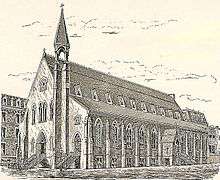J. William Schickel
| J. William Schickel | |
|---|---|
 Church of St. Ignatius Loyola, 980 Park Avenue, New York, New York | |
| Born |
January 29, 1850 Wiesbaden, Hochbein, Germany |
| Died | 1907 |
| Nationality | USA, German |
| Known for | Architect |
J. William Schickel, FAIA, (1850–1907) known professionally as William Schickel, was a German-American architect and founder of the New York architectural firm of Schickel & Ditmars.
Life and practice
Schickel was born January 29, 1850 in Wiesbaden, Hochbein, Germany. He was a student of Wilhelm Bozler. In 1870, at the age of twenty, he emigrated to the United States, passing through Castle Garden in New York City, and the next day started his New York architectural career in the offices of the renowned Richard Morris Hunt.[1] He became a member and a Fellow of the American Institute of Architects in 1894.[2] In 1885 he formed William Schickel & Company in association with Isaac E. Ditmars (1850–1934) and Hugo Kafka (1843–1913). He died June 14, 1907 in New York City.[3] Following his death, Ditmars continued the firm.
Works

The John Crimmins House at 40 East 68th Street was the German-born Schickel's first commission in New York.
Schickel was hired in 1879 to design and build a replacement for the original 1867 chapel of the Church of St. Vincent Ferrer (New York City). The church was known as the "Gothic Barn" and was demolished in 1914. Along with this commission came one to build a priory that would serve as the provincial headquarters for the Dominicans in New York. The priory's intricate use of materials and its overall polychromy, characteristics of the High Victorian Gothic style popular in the late 19th century, reflect Schickel's training in Bavaria and the strong influence there of Friedrich von Gärtner. It was the first of many buildings Schickel would design for the New York diocese.[4] The priory still stands.

Among Schickel's most celebrated works were the impressive German-Baroque edifice of St. Ignatius of Loyola (1898), now on the National Register of Historic Places ,[5] and the Neo-Gothic St. Louis's Church (1889) in Buffalo, New York, with elements of French and German Gothic design including a pierced spire influenced by Cologne Cathedral.[6] His firm had long-standing ties to leading German-American families and the Roman Catholic Church, principally building churches and ecclesiastical complexes in German-American neighborhoods. Among many other church structures in the United States, Schickel was the architect of the Most Holy Trinity Church,[7] 138 Montrose Ave., Brooklyn, New York. The cornerstone of Most Holy Trinity was placed in 1882 and after three years of construction the church was opened in 1885.[8] Schickel also designed the massive St. Joseph Seminary, Dunwoodie, NY, begun 1893 and taking five years to complete.[9]
Partial List of Solo Works
For work done with William Schickel & Company (1885) and Schickel & Ditmars (1885-1907), see Schickel & Ditmars
- The Staats-Zeitung Building,[1] 17 Chatham Street (Park Row), New York City, New York (1873, demolished 1907 for the New York Municipal Building)
- St. Francis Church, Monastery, and School, Milwaukee, Wisconsin (1877), National Register of Historic Places
- Basilica of Our Lady of Perpetual Help, Boston, (1874-8), better known as Mission Church (in association with Edward Welby Pugin) National Register of Historic Places
- The John D. Crimmins, Esq., Residence, 40 East 68th Street, New York City, New York, (1878-9)[1]
- Old Church of St. Vincent Ferrer (New York City) and Priory, New York City, New York (1879, demolished 1914)
- Century Building (17th Street, Manhattan), 33 East 17th Street, New York City, New York (1880-1), National Register of Historic Places, New York City Landmark
- William Schickel House, 52 E 83rd Street, New York City, New York (1881-2), National Register of Historic Places
- The Constable Building Annex, 9-13 East 18th Street, New York City, New York (1883-4)
- The German Library and Dispensary 135-137 Second Avenue, New York City, New York (1883-4), National Register of Historic Places, New York City Landmark
- St. Liborius Church, St. Louis, Missouri (1889) National Register of Historic Places, St. Louis Landmark
- The Mercer Hotel, 1890
- St. Joseph's Church, Yorkville, Manhattan, New York (1894–95)
See also
References
- Notes
- 1 2 3 J. William Schickel at the archINFORM database.
- ↑ The AIA Historical Directory of American Architects
- ↑ Henry F. Withey, A.I.A., and Elsie Rathburn Withey, Biographical Dictionary of American Architects (Deceased) (Los Angeles: New Age Publishing Company, 1956. Facsimile edition, Hennessey & Ingalls, Inc., 1970)
- ↑ O'Brien, Austin (March 1981). "National Register of Historic Places nomination, St. Vincent Ferrer Church and Priory". New York State Office of Parks, Recreation and Historic Preservation. Retrieved April 6, 2010.
- ↑ "Church History - Church of St. Ignatius Loyola, NYC". Retrieved 27 September 2014.
- ↑ Schickel and Ditmars
- ↑ mhtbrooklyn.org
- ↑ http://eagle.brooklynpubliclibrary.org/Default/Skins/BEagle/Client.asp?Skin=BEagle&AW=1276718678750&AppName=2&GZ=T
- ↑ The Archdiocese of New York the Bicentennial History, Rev. Thomas J. Sheiley page 401
External links
![]() Media related to William Schickel at Wikimedia Commons
Media related to William Schickel at Wikimedia Commons